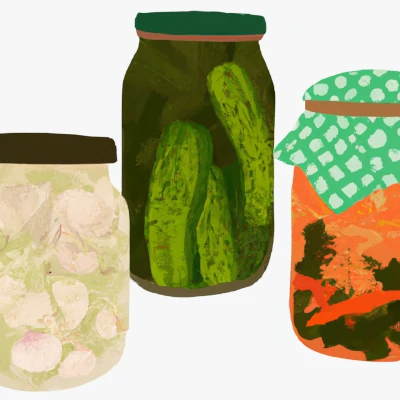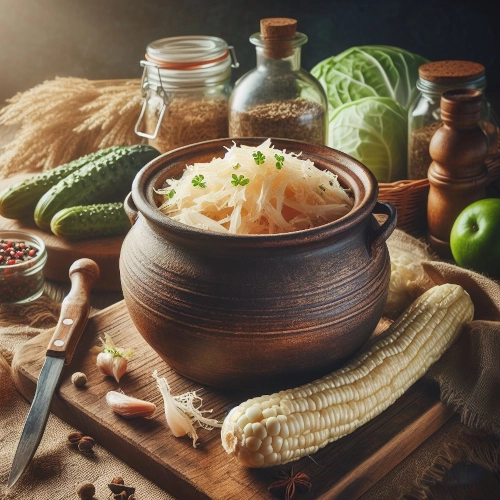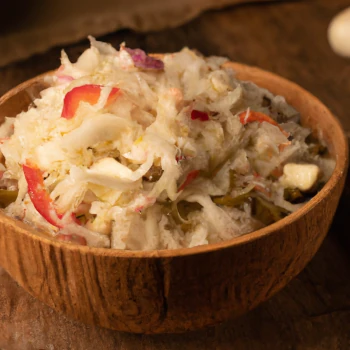Granny's Guide to Fermentation

Fermentation is not just a culinary technique, but a testament to human innovation and survival. It has allowed us to preserve food, enhance its nutritional value, and create a diverse array of flavors and textures that have become integral to our culinary traditions. From the tangy bite of sauerkraut to the effervescence of champagne, the influence of fermentation can be tasted in every corner of the world. As we continue to explore and understand this process, we are finding new ways to harness its potential, not just in food production, but also in health and sustainability. This guide invites you on a journey to explore the art and science of fermentation, a process as old as civilization itself, yet continually unfolding in new and exciting ways.

The History of Fermentation
The history of fermentation is deeply intertwined with the history of human civilization itself. The process, believed to have been discovered around 10,000 BC during the Neolithic age, was likely stumbled upon by our ancestors as they began to transition from a nomadic lifestyle to one of agriculture and settlement. The earliest tangible evidence of fermentation comes from ancient pottery jars discovered in China, dating back to 7000 BC. These jars contained residues of a fermented beverage, suggesting that our ancestors were already harnessing the power of fermentation to create consumable goods long before the advent of written language.
Over the centuries, the art and science of fermentation have been employed to produce a diverse array of foods and beverages. The Romans, for instance, were known for their fermented fish sauces, which were a staple of their cuisine and a testament to their innovative use of available resources. In medieval Europe, beer, a product of fermentation, was not just a popular beverage but also a vital source of nutrition. It was often safer to drink than water due to the alcohol's ability to kill off harmful bacteria.
Each culture across the globe has developed its unique fermented foods and beverages, reflecting their local tastes, available ingredients, and culinary traditions. In Japan, for example, the process of fermentation is used to produce sake, a rice wine that is integral to Japanese culture. In India, fermentation is used in the preparation of a variety of dishes, including dosa and idli. In the Americas, indigenous peoples have long used fermentation to produce beverages like chicha and pulque. And European settlers brought along their own fermented food recipes for foods like sauerkraut and pickles.
The Science Behind Fermentation

Fermentation is a fascinating biochemical process that has been utilized by humans for thousands of years, not only as a means of food preservation but also as a way to develop complex flavors and enhance nutritional value. At its core, fermentation is an anaerobic (oxygen-free) metabolic process in which microorganisms—such as bacteria, yeast, and molds—convert organic compounds, primarily carbohydrates, into simpler molecules like acids, gases, or alcohol. This transformation occurs through enzymatic reactions that help break down sugars and starches into new compounds, often resulting in distinctive flavors, textures, and health benefits.
The science of fermentation is deeply intertwined with microbiology and biochemistry, as different microbial strains are responsible for producing unique byproducts. For example, yeast is essential for alcoholic fermentation, producing ethanol and carbon dioxide, while lactobacilli bacteria drive lactic acid fermentation, leading to the characteristic tangy flavors of yogurt, kimchi, and pickles. Additionally, molds such as Aspergillus oryzae play a key role in fermenting soybeans into miso and soy sauce. Because of the diverse range of microorganisms involved, fermentation has played a fundamental role in food culture across nearly every civilization, leading to a vast array of fermented products from different regions of the world.
While initially discovered through trial and error, modern science has uncovered the intricate mechanisms behind fermentation. Researchers have found that fermentation not only extends shelf life by inhibiting harmful bacteria but also enhances the bioavailability of nutrients, making certain vitamins and minerals easier for the body to absorb. Additionally, fermented foods contribute to gut health by introducing beneficial probiotics, which help maintain a balanced microbiome. Whether through the spontaneous fermentation of wild microbes or controlled fermentation using starter cultures, this natural process remains one of the most important biochemical transformations in both traditional and industrial food production.
Types of Fermentation
There are several types of fermentation, each involving different microorganisms and resulting in distinct products:
Alcoholic Fermentation
Alcoholic fermentation is carried out primarily by yeasts, such as Saccharomyces cerevisiae. When yeast cells metabolize glucose in the absence of oxygen, they produce ethanol (alcohol) and carbon dioxide as byproducts:
C₆H₁₂O₆ → 2C₂H₅OH + 2CO₂
This reaction is the foundation of alcoholic beverages like beer, wine, and spirits. In bread-making, the carbon dioxide released during this process is what causes dough to rise, creating the airy texture of baked goods.
Lactic Acid Fermentation
Lactic acid fermentation is performed by various strains of bacteria, primarily Lactobacillus, Leuconostoc, and Streptococcus. These bacteria convert sugars into lactic acid, a process that contributes to the sour taste and extended shelf life of foods like yogurt, sauerkraut, kimchi, and pickles:
C₆H₁₂O₆ → 2C₃H₆O₃
This acidification process inhibits the growth of harmful bacteria, acting as a natural preservative.
Acetic Acid Fermentation
Acetic acid fermentation occurs when ethanol is further oxidized by Acetobacter bacteria in the presence of oxygen. This process results in the production of acetic acid, which gives vinegar its characteristic tangy taste:
C₂H₅OH + O₂ → CH₃COOH + H₂O
Vinegars, including apple cider vinegar and balsamic vinegar, owe their acidity to this process.
Propionic Acid Fermentation
This type of fermentation, carried out by Propionibacterium, is responsible for the production of propionic acid and carbon dioxide. It plays a crucial role in the formation of Swiss cheese, contributing to its distinctive flavor and characteristic holes.
Fermentation and Human Health
Beyond its culinary applications, fermentation offers several health benefits:
- Probiotic Growth: Fermented foods are rich in beneficial bacteria that promote gut health by supporting the microbiome.
- Enhanced Nutrient Absorption: Fermentation can break down antinutrients, such as phytic acid in grains and legumes, making minerals like iron, calcium, and zinc more bioavailable.
- Improved Digestibility: The breakdown of complex carbohydrates and proteins can make certain foods easier to digest, particularly for individuals with lactose intolerance (as seen in yogurt).
- Immune Support: A healthy gut microbiome, supported by probiotics, plays a crucial role in immune function.
The Benefits of Fermentation
The benefits of fermentation extend beyond just altering the taste and texture of foods. It also offers several health benefits, particularly in relation to gut health. Fermented foods are rich in probiotic bacteria, which are beneficial to our gut microbiome. Consuming these foods can enhance the diversity and health of our gut flora, which in turn can improve digestion and boost the immune system.
Fermented foods are also generally easier to digest. The fermentation process breaks down complex molecules into simpler ones, making it easier for our bodies to absorb the nutrients. For example, the lactose in milk is broken down into simpler sugars - glucose and galactose - during the fermentation process to make yogurt, making it easier to digest for those who are lactose intolerant.
Moreover, fermentation can enhance the nutritional profile of food. It can increase the levels of certain nutrients, such as B vitamins and omega-3 fatty acids, and also produce various strains of probiotics. These microorganisms not only promote gut health but also have been linked to a range of health benefits, including improved mental health and weight management.
Fermented foods will also last longer than their untreated counterparts. The process of fermentation creates an environment that is unfavorable for the growth of harmful bacteria. This is primarily due to the production of alcohol or acids (like lactic acid or acetic acid) during fermentation. These substances create a low pH environment that most harmful bacteria cannot survive in, thus acting as a natural preservative.
For example, in the case of sauerkraut, the lactic acid produced during fermentation prevents the growth of harmful bacteria, allowing the cabbage to be stored for longer periods without spoiling. Similarly, the alcohol produced during the fermentation of beer or wine acts as a preservative, preventing spoilage and extending shelf life.
Fermentation in the Modern World

In the modern world, the art and science of fermentation have seen a resurgence. This revival is driven by a growing interest in sustainable living, home cooking, and the health benefits of fermented foods. The process of fermentation, once a necessity for preservation and survival, is now being embraced for its ability to enhance flavor, improve gut health, and connect us to our culinary heritage.
Home fermenting kits have become widely available, allowing individuals to experiment with creating their own fermented foods. From sauerkraut balls to sourdough, people are discovering the joy and satisfaction that comes from watching the transformative process of fermentation happen right in their own kitchens.
In the realm of gastronomy, fermentation is being recognized as a tool for culinary innovation. Chefs around the world are experimenting with fermented ingredients to create unique and exciting flavors. From kombucha to kimchi, fermented foods are appearing on menus and in grocery stores like never before, reflecting a growing appreciation for the depth and complexity that fermentation can bring to food.
The Future of Fermentation: A Healthier, Tastier Tomorrow
Fermentation is a fascinating process with a rich history and a wide array of uses. It's a testament to our ancestors' ingenuity and their understanding of the natural world. Whether you're a food lover, a history buff, or someone interested in a healthier lifestyle, the world of fermentation has something to offer you.
In the end, fermentation is about more than just food and drink. It's a connection to our past, a link to our environment, and a gateway to a healthier future. So why not give it a try? The world of fermentation awaits you. Whether you're fermenting your own vegetables at home or sampling a new fermented beverage at a local restaurant, there's a whole world of flavors and health benefits to discover.
Fermentation is a journey of discovery, a culinary adventure that connects us to the very essence of life. It's a process that reminds us of the beauty of nature, the importance of tradition, and the joy of creation. So, dive into the world of fermentation. Who knows what delicious discoveries await you?

Fermentation Recipes
Unlock the magic of microbes in your kitchen with fermented recipes. These dishes harness nature's tiny helpers to create unique flavors and textures. Explore how simple ingredients transform over time, boosting both taste and nutrition.
-

Homemade Sauerkraut
Full of tangy goodness, sauerkraut combines crisp cabbage and beneficial probiotics in every forkful. The fermentation process brews up a complex flavor profile, packed with gut-healthy nutrients and a great crunch.
-

Sourdough Bagels
These bagels are a perfect breakfast treat that you can now make in your own kitchen. A touch of honey creates a bagel that is both hearty and delicious.
-

Granny's Tangy Sauerkraut Salad
Experience the unique tang of Granny's Tangy Sauerkraut Salad, a delightful mix of fermented cabbage, crisp vegetables, and a sweet and sour dressing.